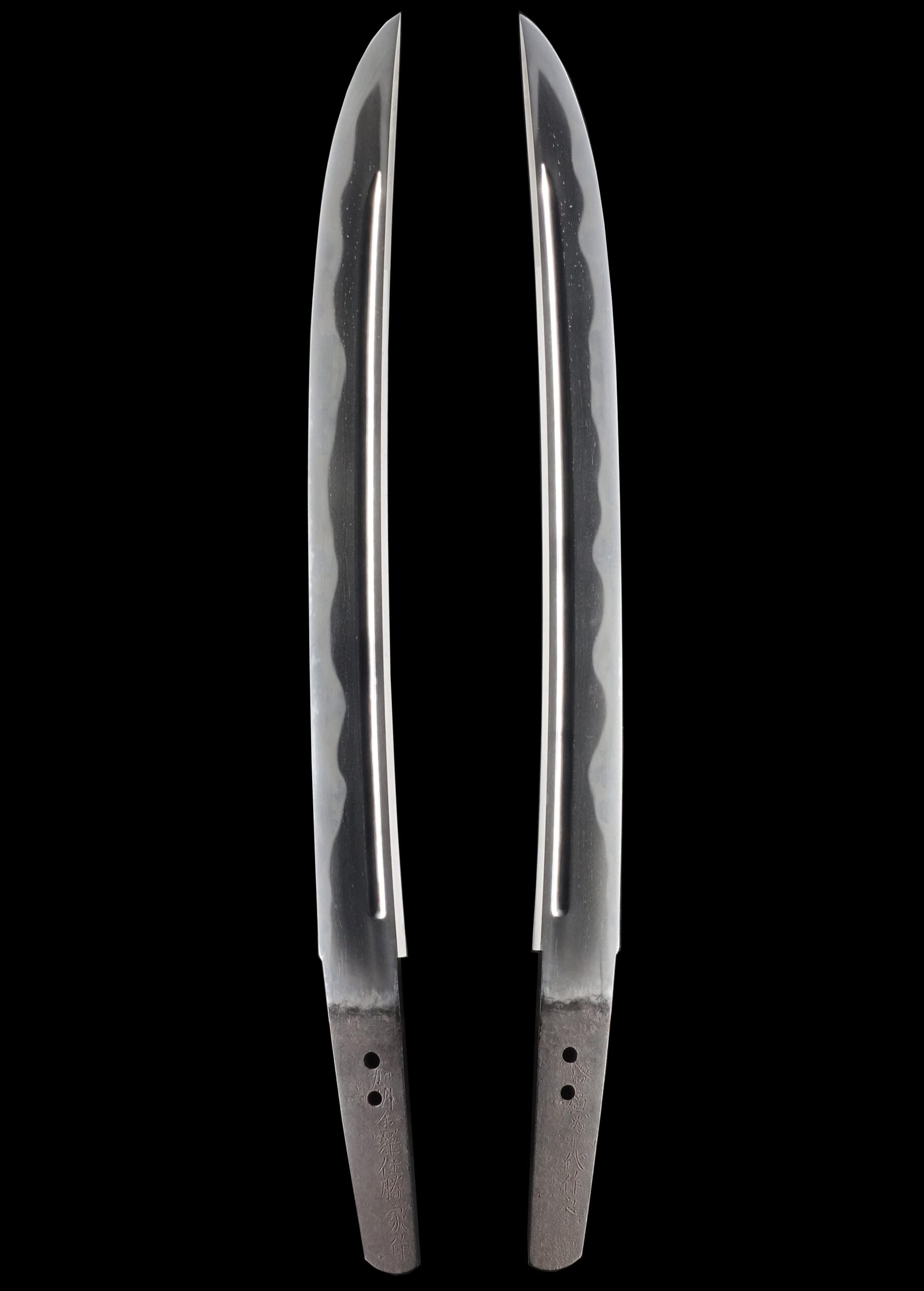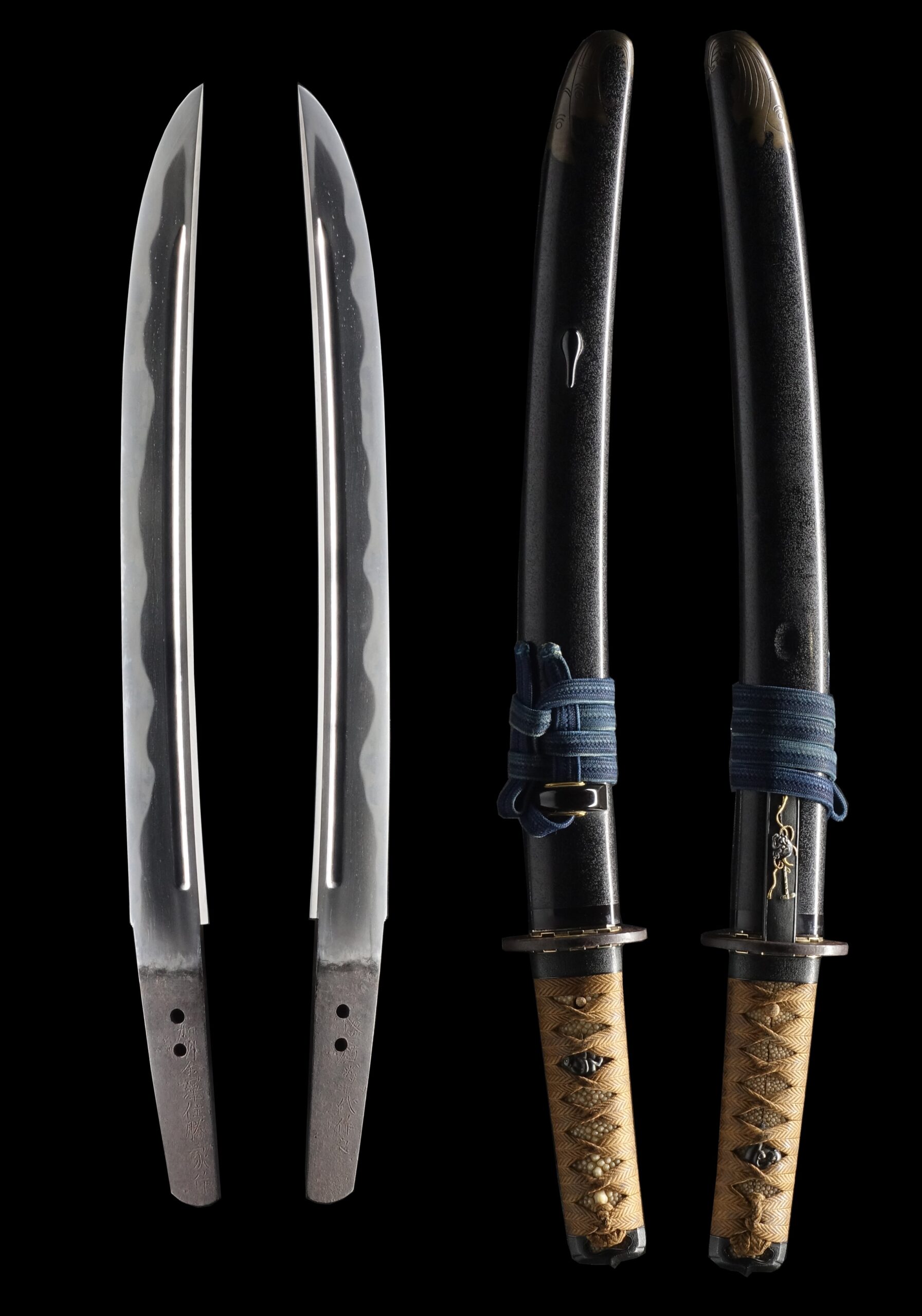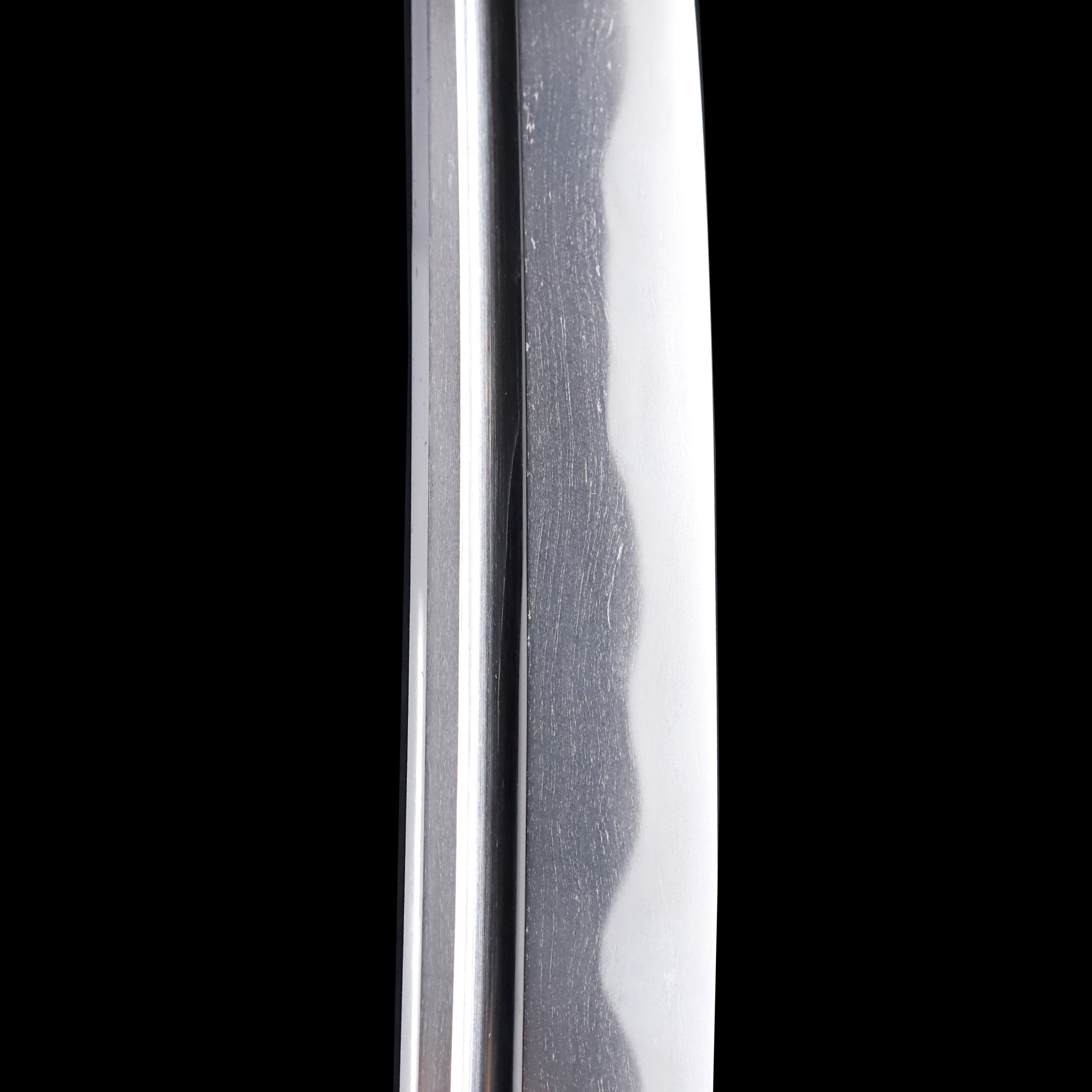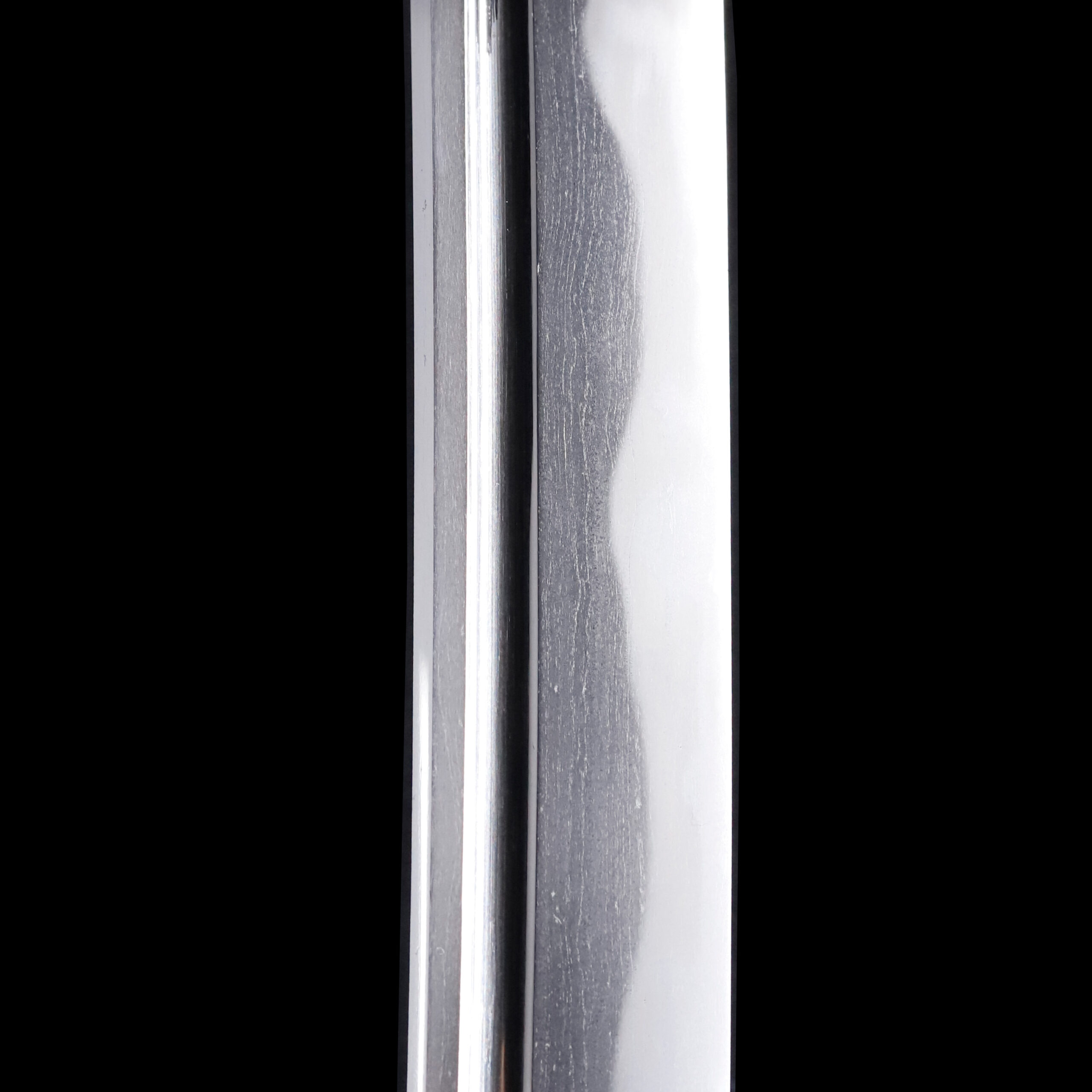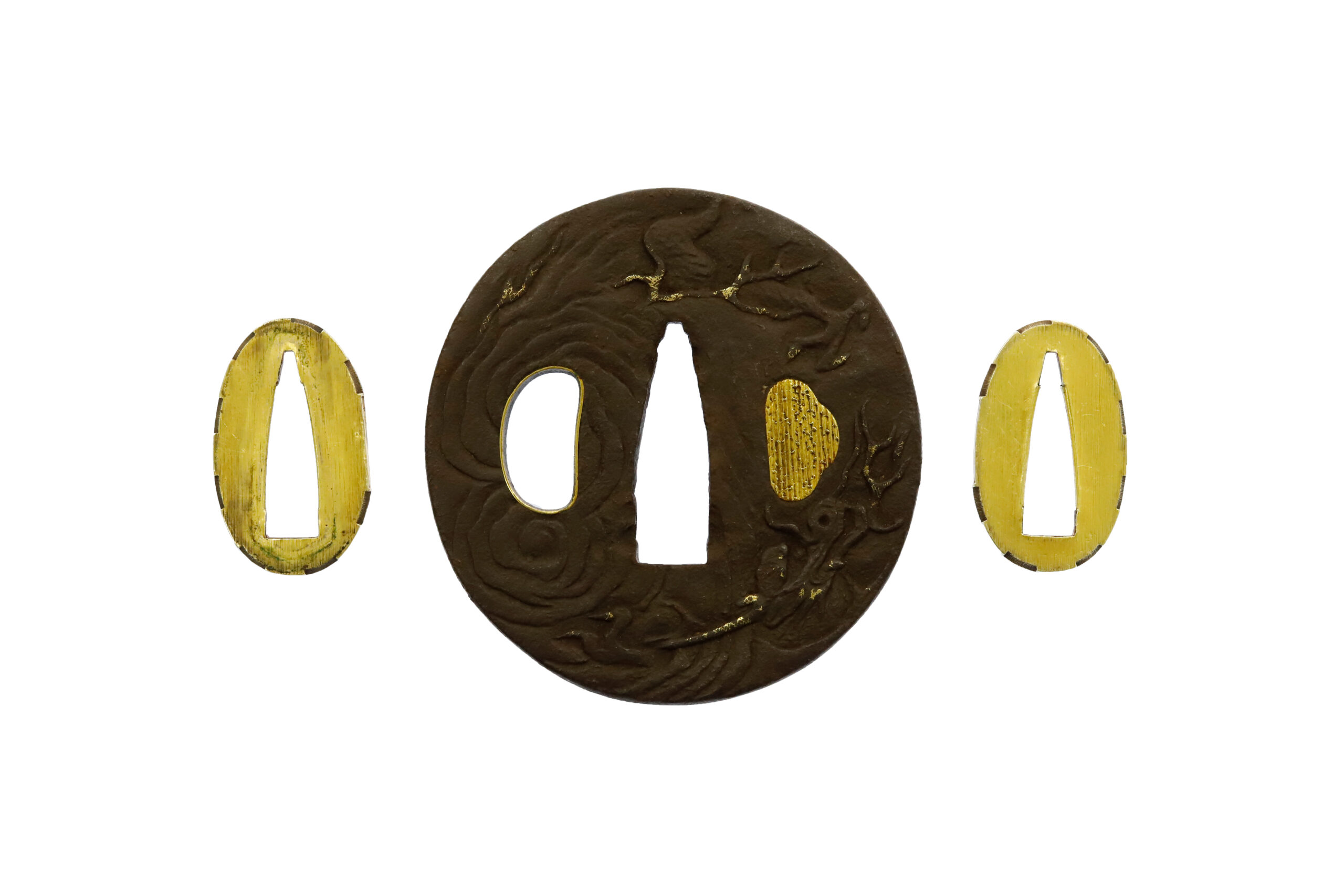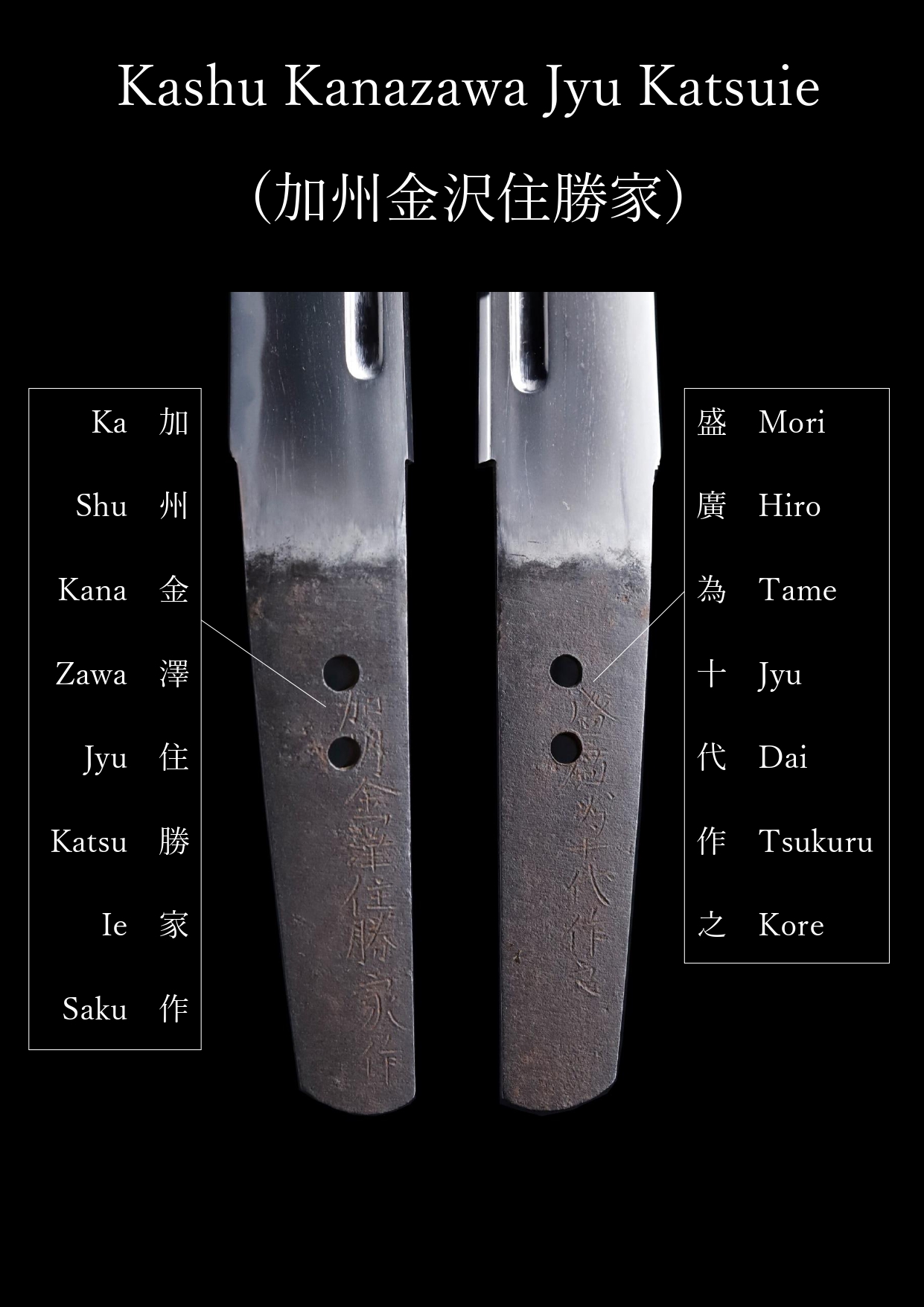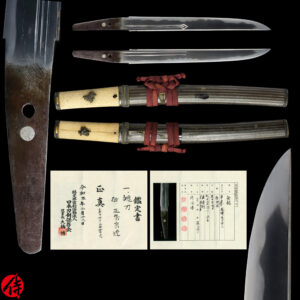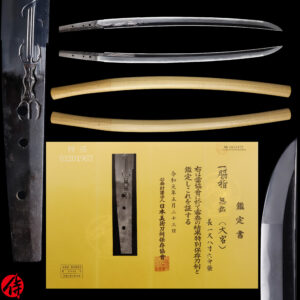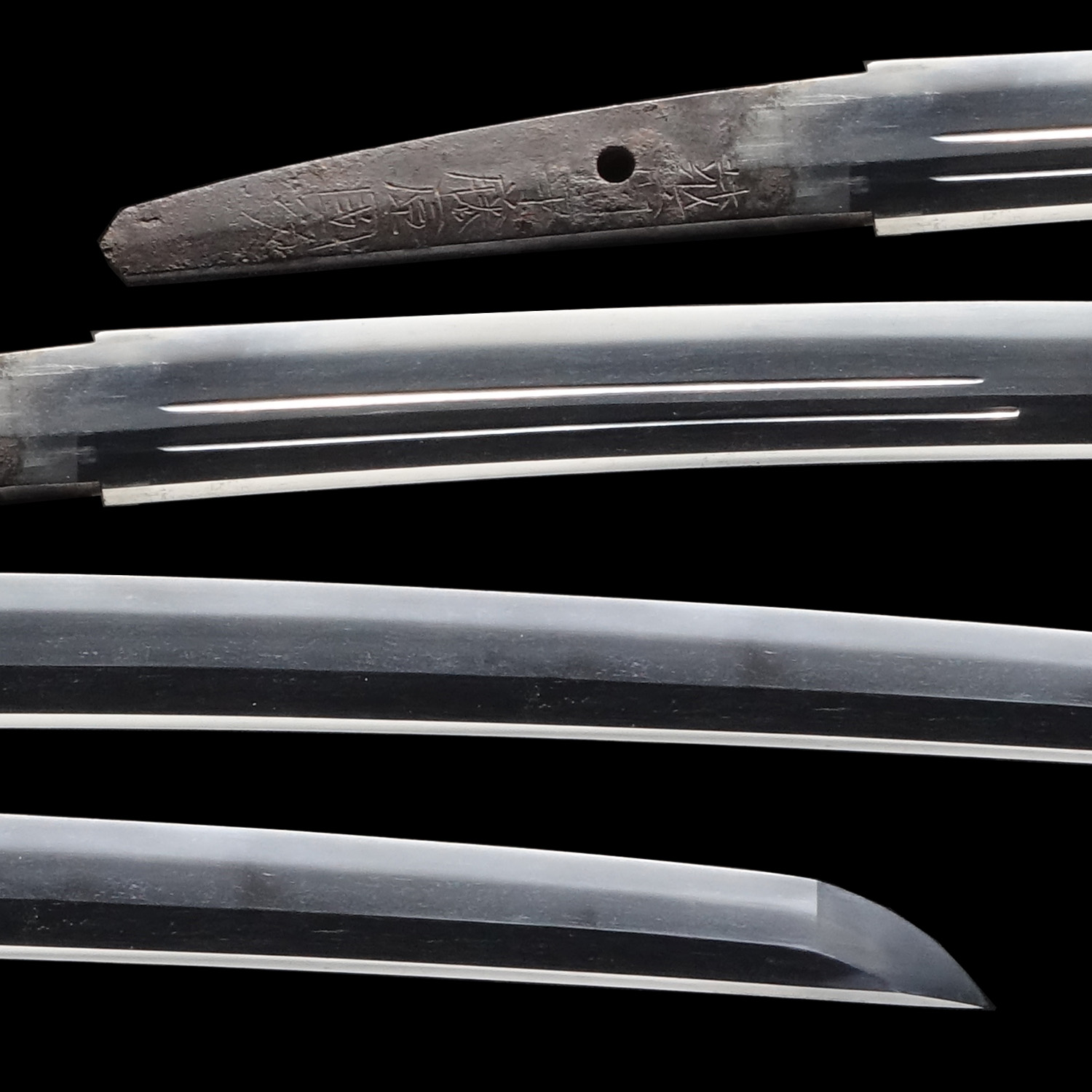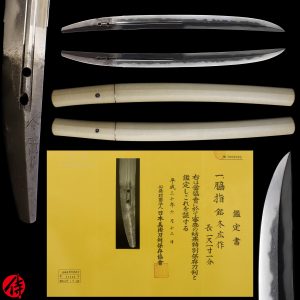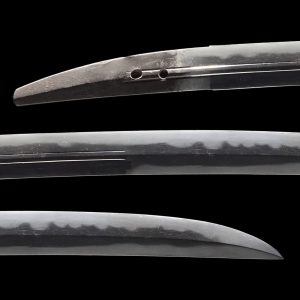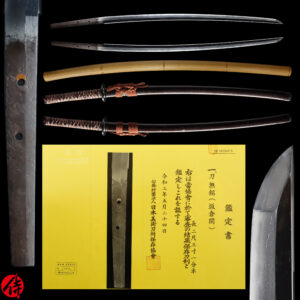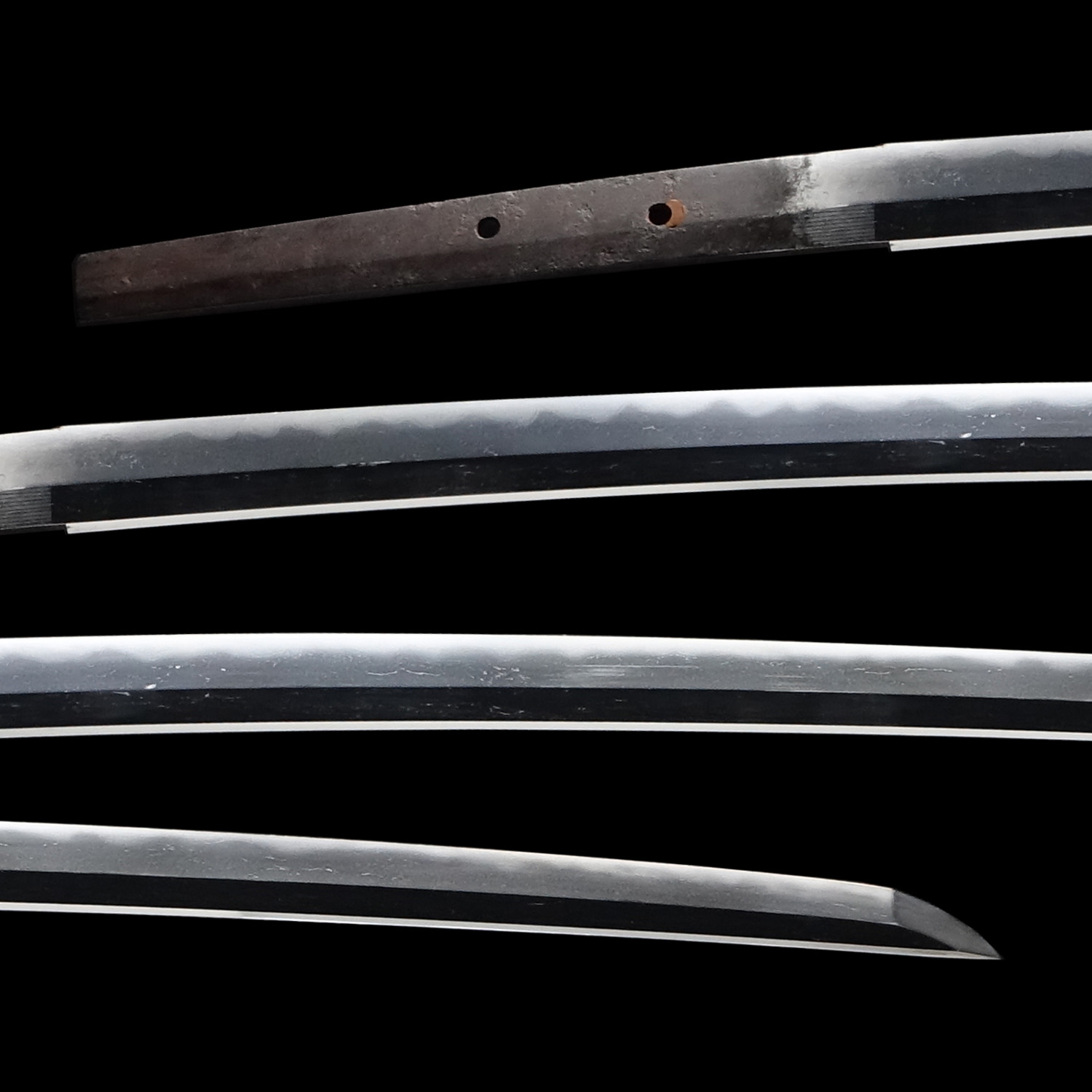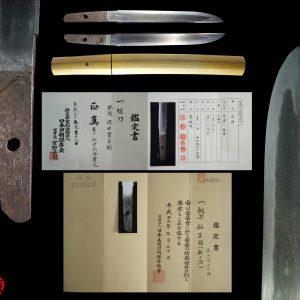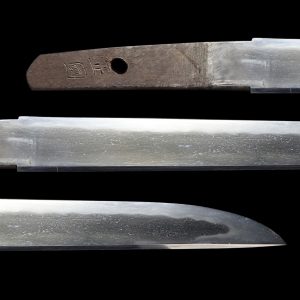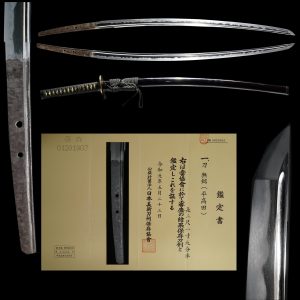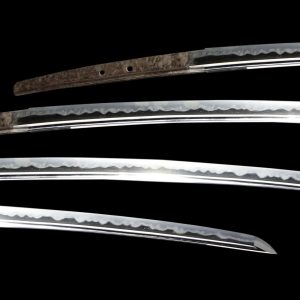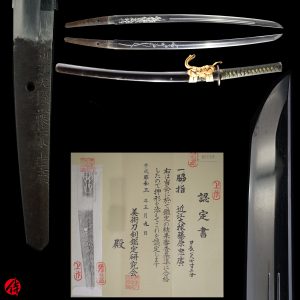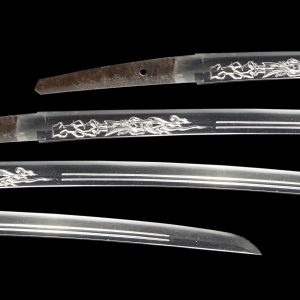Antique Japanese Sword Wakizashi Signed by Kashu Katsuie with NBTHK Tokubestsu Hozon Certificate
【Description】
Summary
This blade was signed by Kashu Kanazawa Jyu Katsuie (加州金沢住勝家). Kashu is the name of the province located in today’s Ishikawa prefecture. And Kanazawa is the biggest city there. Kashu Kanawa Jyu means that Katsuie resided in this area when he forged this blade. The swordsmith’s name, “Katsuie” (勝家), lasted several generations from the middle of the Muromachi to the early Edo period (the 1450s-1650s). Based on the signature, we believe it was ordered by a person named Morihiro (盛広).
The first-generation Katsuie was originally from Mino province (Today’s Gifu prefecture), famous for the sword-forging tradition called MINO-DEN(美濃伝). He and his apprentices moved to Kaga Koku (Today’s Ishikawa prefecture) in the middle of the Muromachi period(the 1450s). They founded a Darani(陀羅尼) school after being hired by the monks there. However, from the second generation, Katsuie served the famous feudal clan, Maeda family, and the generations of Katsuie forged blades for this clan. It was honorable for any swordsmith to serve a feudal clan exclusively.
According to NBTHK, which appraised this blade, this blade was forged during the late Muromachi period based on its characteristics. That means it was made in the middle of Sengoku Jidai(Warring state period) when there was so much rivalry between warlords trying to gain political power nationwide. It would be nice to have a piece that survived through this period.
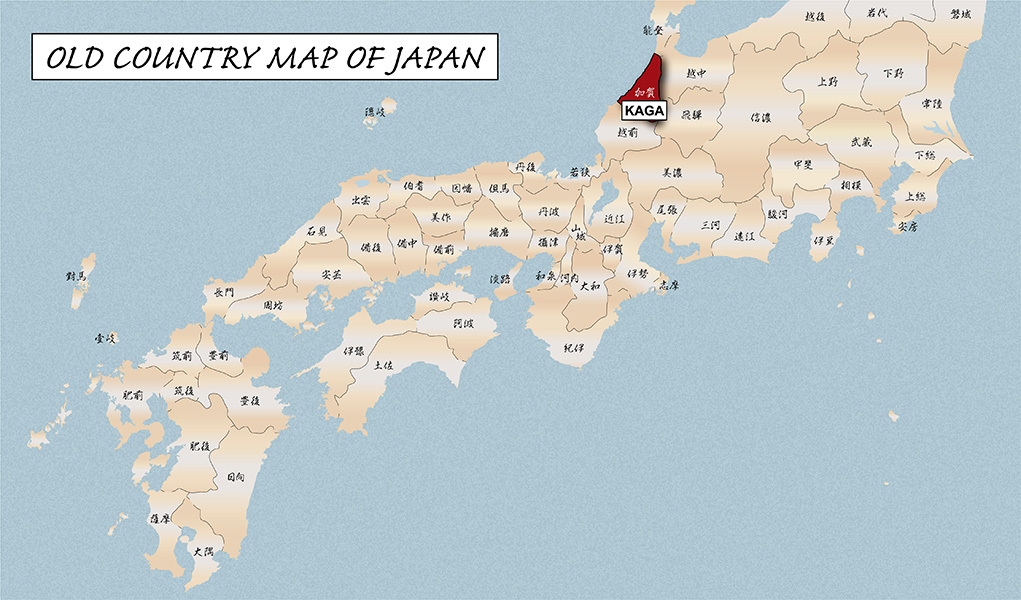
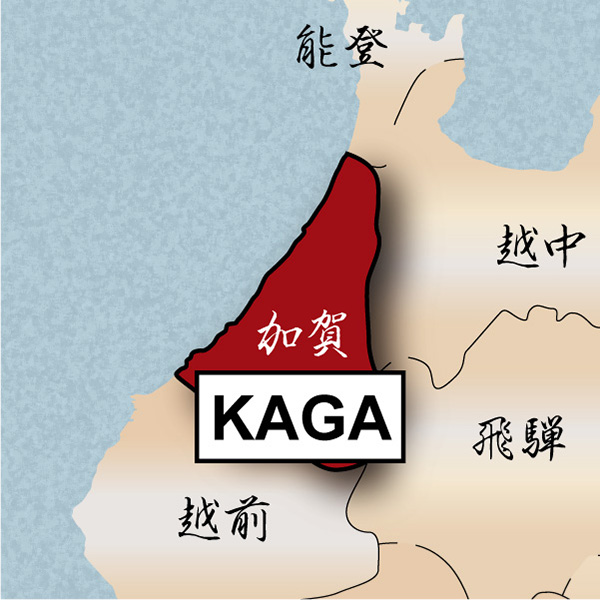
Maeda Clan
Maeda clan was originally a retainer of Oda family, who ruled Owari province. (today’s Nagoya area in Aichi prefecture) The first head of the Maeda clan was Toshie Maeda. He climbed the social ladder of Samurai society, and he became the feudal lord of Kaga Province(today’s Ishikawa prefecture). It is said that he had a vast rice fief that fed 100 million grown-up adults, which is called Hyakuman Goku. The Maeda clan was one of the most powerful lines in Samurai history. Toshie Maeda had a close tie with Oda Nobunaga and Hideyoshi Toyotomi.
This blade is appraised as a Tokubetsu Hozon Token(特別保存刀剣) issued by NBTHK(Nihon Bijutsu Touken Hozon Kyokai:日本美術刀剣保存協会). This authentication paper was only given to authentic Japanese swords, especially well preserved and high quality with artistic value.
【Blade】
Cutting Edge Length(Nagasa): 35.9 cm ( 14.1 inches)
Curvature(Sori):0.6 cm (0.23 inches)


Hamon:
The crystalline structure which forms along the cutting edge of a blade as a result of the hardening process
Jimon(Jihada):
visible steel surface pattern created by folding and hammering during forging process
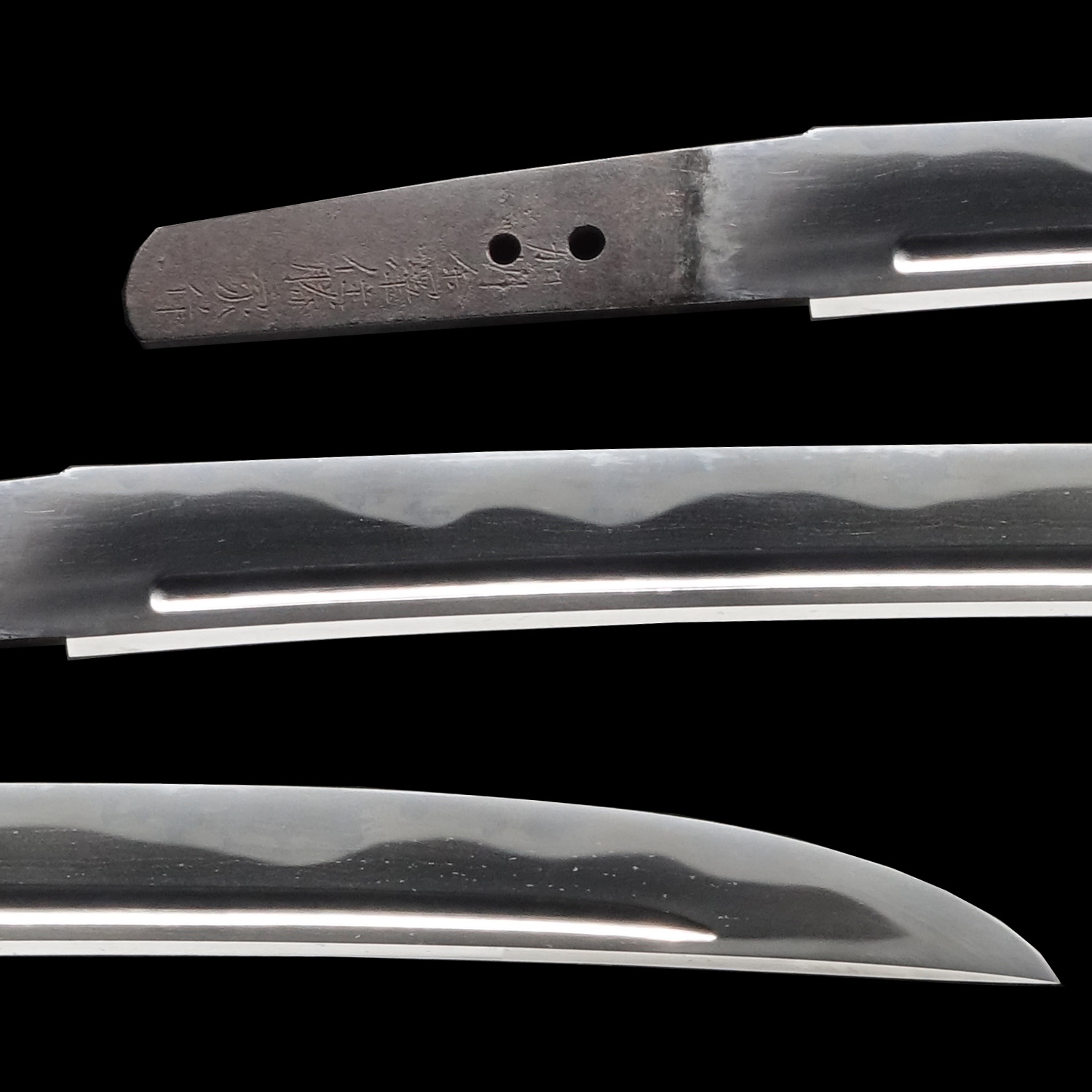
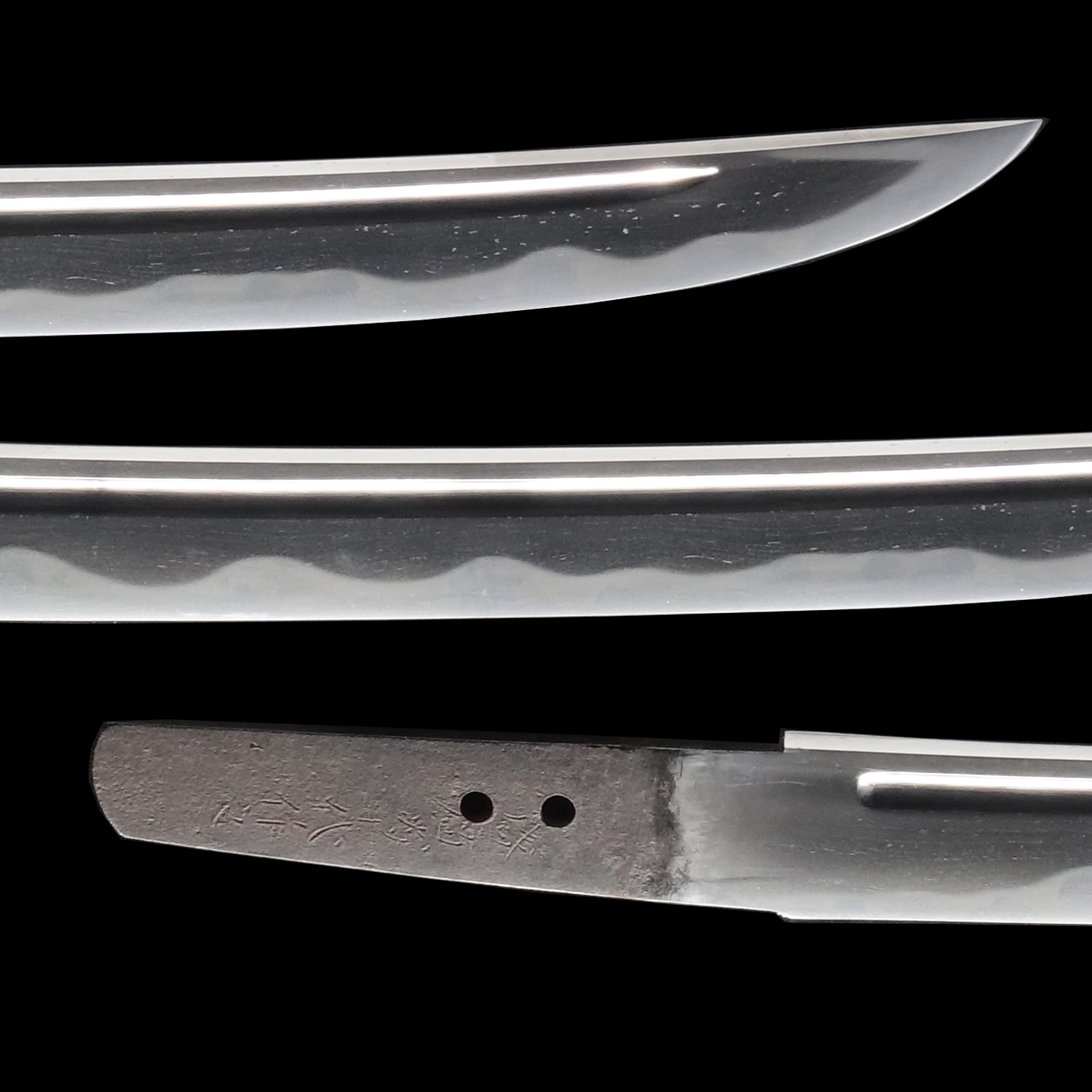
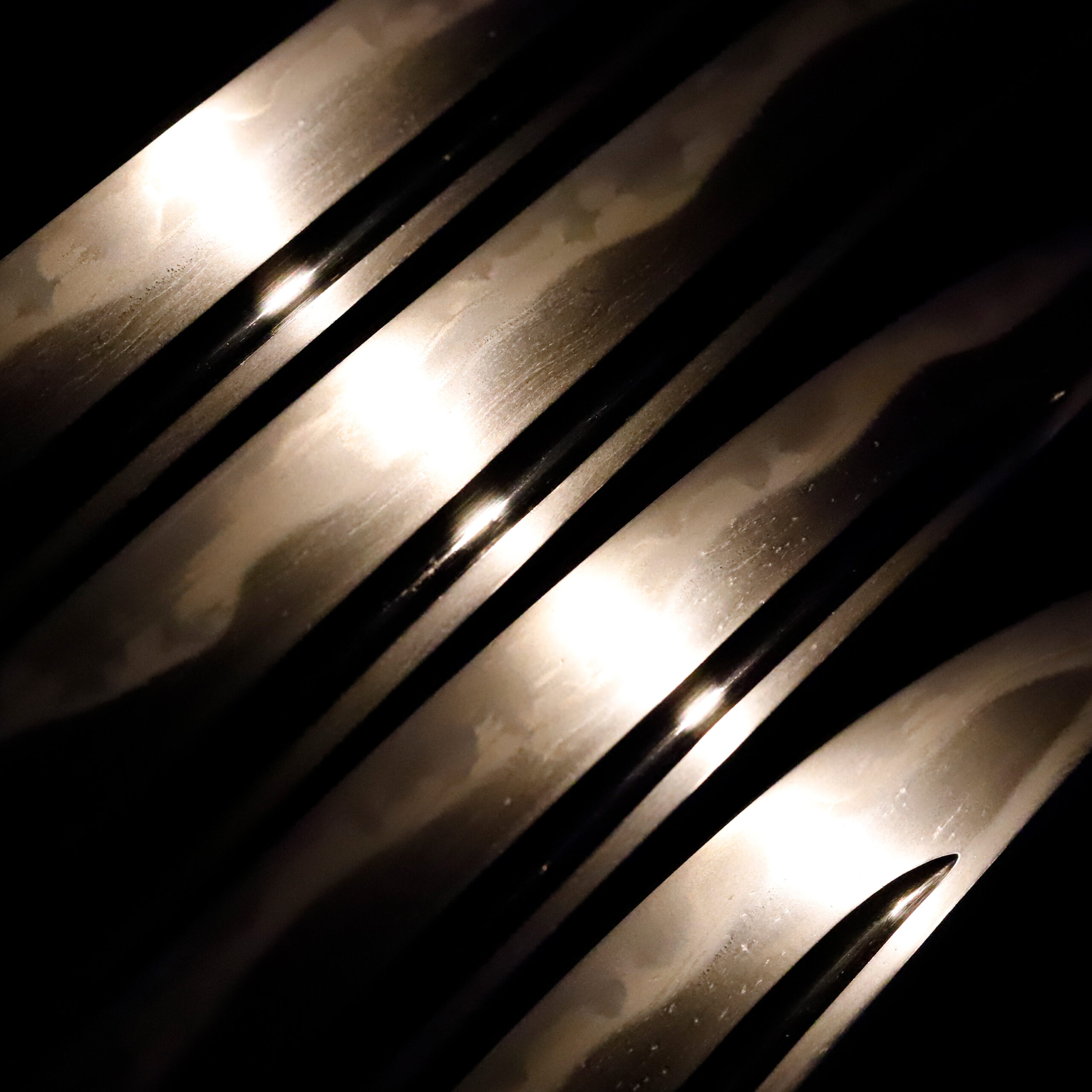
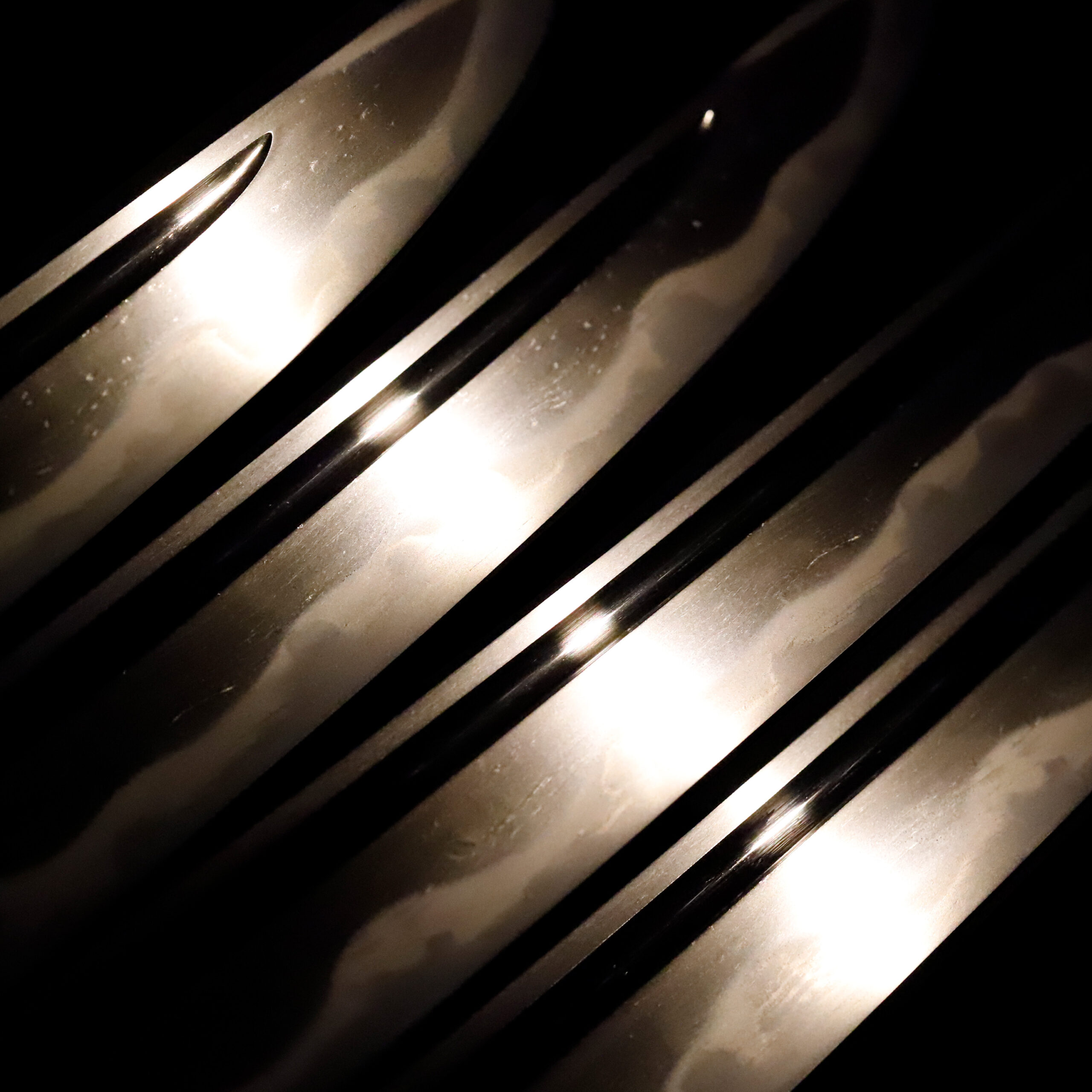
Nakago:Nakago is the tang of the Japanese sword.
Japanese swordsmiths left the black rust on the tang because it prevents red rust while the tang is in its handle. And the discoloration of the tang was created over time, and it is a great indicator for a Japanese sword specialist to estimate when the sword was forged.
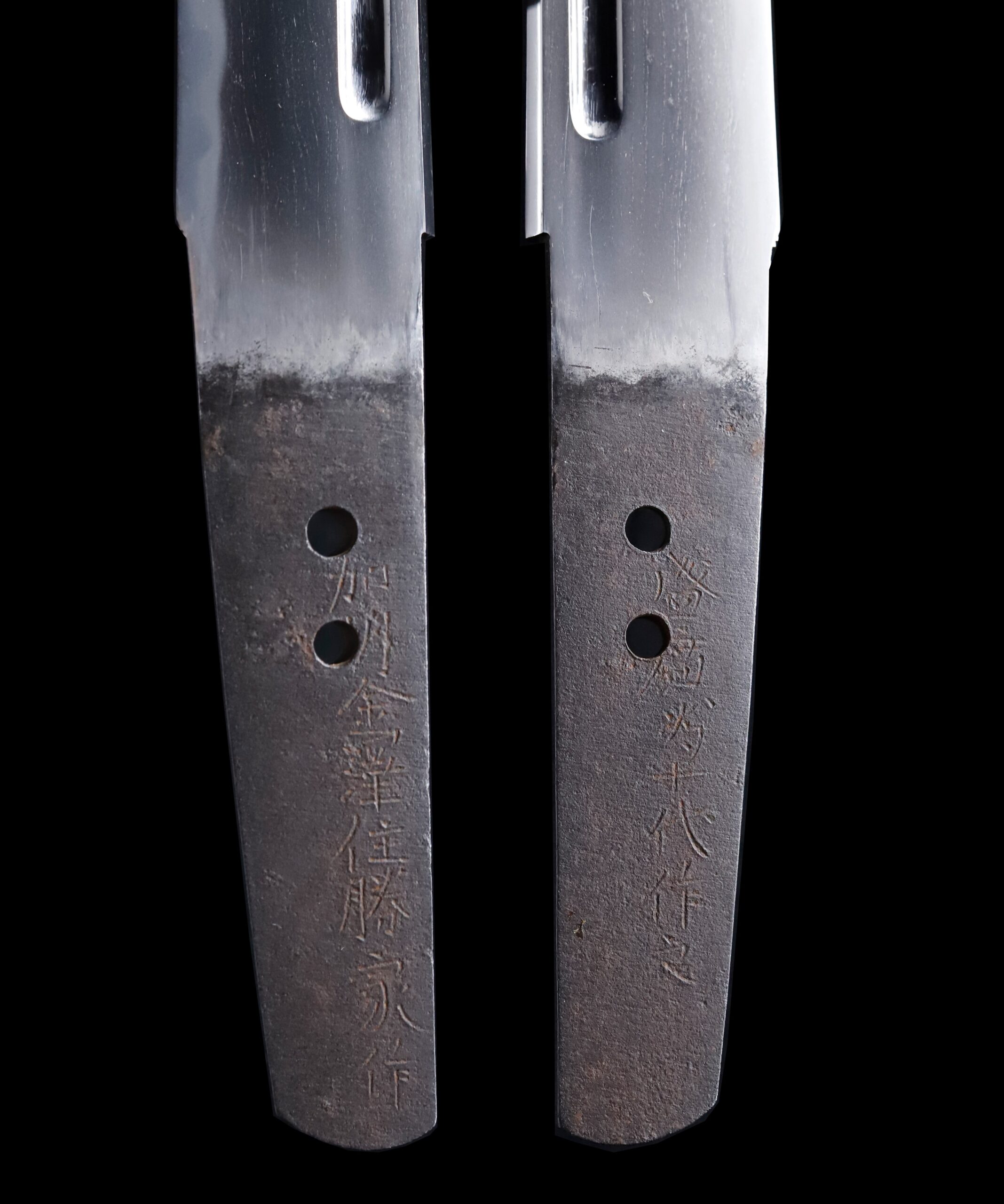
Koshirae: Koshirae is the mounting of the Japanese sword. There are several parts that consist of Koshirae such as Saya(Scabbard), Tsuka( Handle), Tsuba(Handguard).
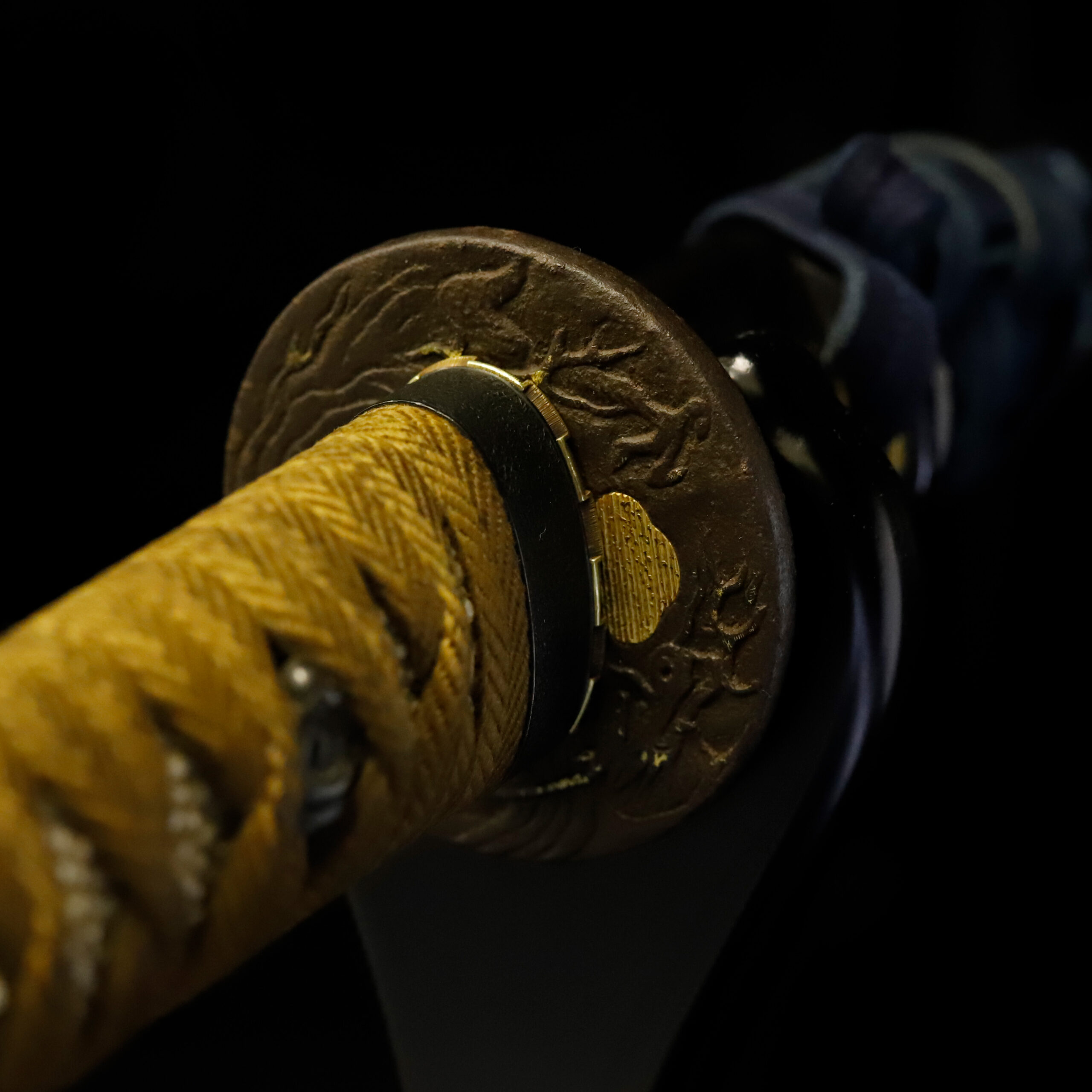
Fuchi-Kashira:A pair of matching sword fittings that cover the upper and bottom parts of its sword hilt.
This Fuchi Kashira has a simple look and has a stone-like rough surface. It has a practical finish by refraining from gorgeous decorations. As it does not have any decorations with gold or silver, you could enjoy copper’s metal color and texture directly.
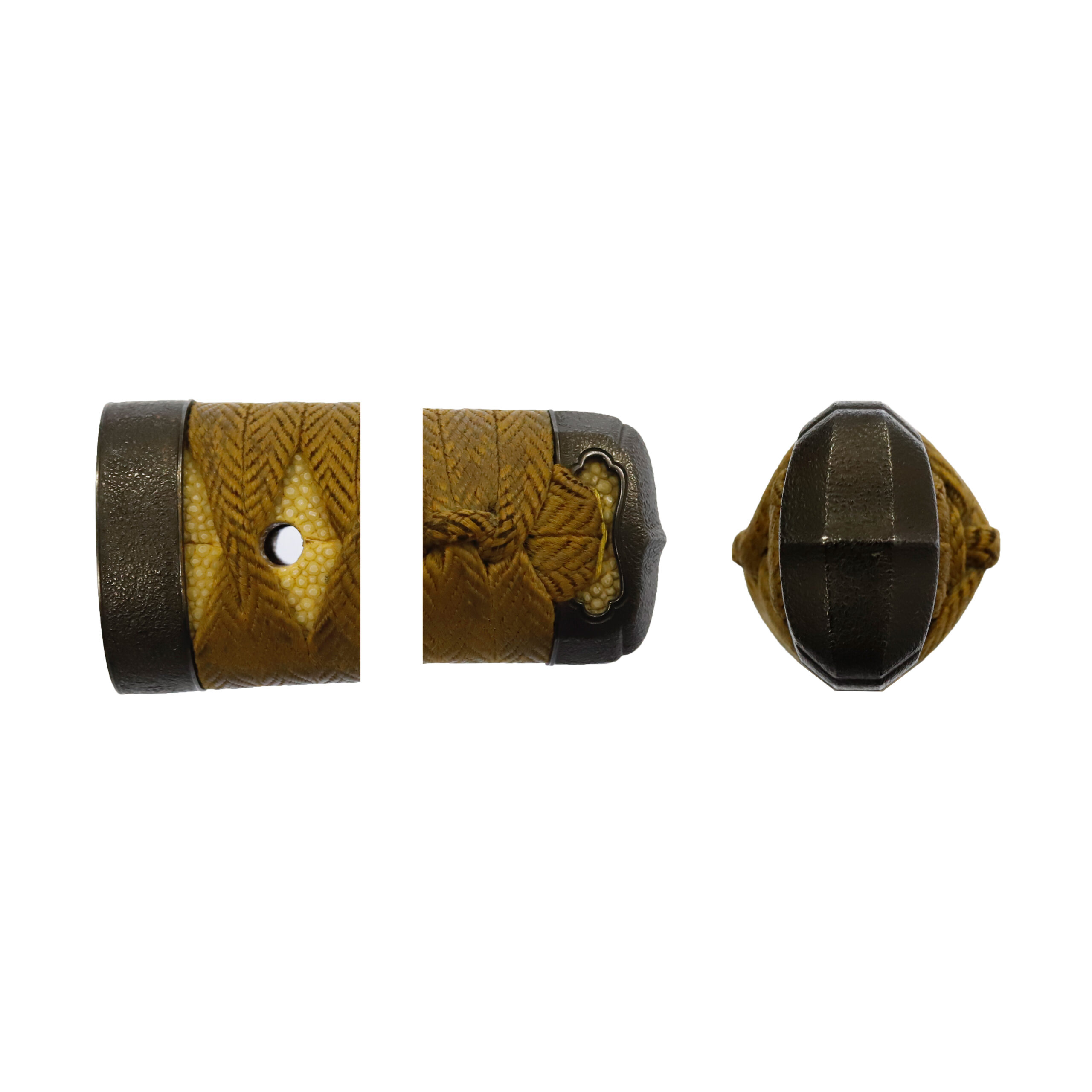
Tsuka and Menuki:Tsuka is the handle of the Japanese sword and Menuki is its decoration.
You would find the figure of the Saru (猿, monkey) on each side of the handle. The upper Menuki’s monkey seems that it is holding something out, and another monkey is about to eat something with its mouth wide open. Generally speaking, as we know, monkeys belong to the same primates as us humans. So it is considered to be the closest animal to humans. Probably, it is why monkeys have often been personified in pictures and stories since ancient times. In this Menuki as well, the figures of monkeys are portrayed with the same gestures as humans.
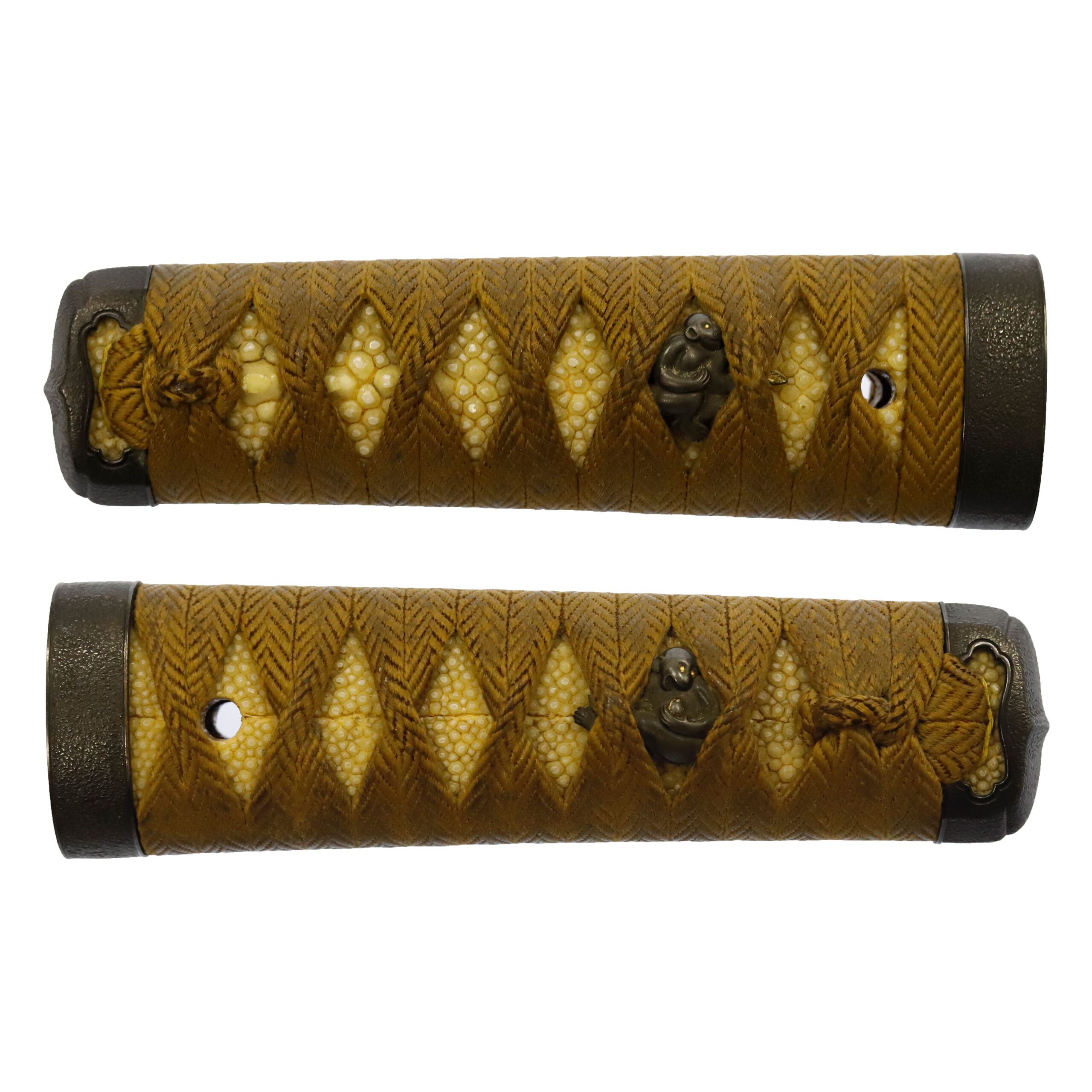

Habaki:Habaki is the equipment to make the blade not touch its scabbard inside. It prevents the blade from getting rusty and chipped.
This oval-shaped Tsuba has a Kozuka hole. Golden metal is applied to the Kougai hole. Its surface has worn away due to aging, making it challenging to see the details of the design. We estimate its theme is a dragon peeking through the clouds. It seems golden paint was applied to here and there. Initially, the dragon was an imaginary creature found in ancient foreign traditions or myths. Furthermore, it is regarded as a symbolic beast of auspicious signs. Its body is likened to nine animals: antlers are deer, the head is a camel, eyes are demons, the neck is a snake, the belly is Mizuchi (蛟, a mythical animal in Japan that looks like a snake and has a horn and four legs), scales are fish, claws are falcons, palms are tigers, and ears are cows. It was thought that the dragon would reign at the top of all animals because of its odd-looking appearance.
Clouds bring blessed rain and snow, and their movements significantly affect the day’s weather. Due to its supernatural power, a theory says that gods, spirits, and dragons dwell in the clouds. Therefore, it is understandable that this combination was incorporated into a design for sword mountings.
Now please focus on the Habaki (鎺). This Habaki has a bright silvery color and an ornamental appearance. The principal motif of each side is the famous family crests. One side is the Agehachou Mon (揚羽蝶紋), and another side is the Oda Mokkou Mon (織田木瓜紋).
Let’s begin with the Agehachou (揚羽蝶, swallowtail) design. People preferred the butterfly pattern due to its growth process, beauty, and auspiciousness among the various animal patterns. A larva becomes a chrysalis, and it grows up into a butterfly. As this insect changes its looks, it symbolizes being reborn; therefore, Samurai loved this design. Also, as butterflies make a couple on good terms, this motif represents happy marriage. It is said that the butterfly pattern has been used since the Heian period (794-1185). This design was brought from the continent to Japan, and people introduced it in various fields. As proof of this, butterflies have also appeared in stories, such as the Heike-Monogatari (平家物語, The Tale of the Heike). This insect design gradually began to be used as a family crest, and it spread nationwide by being used by the Taira (平) clan. Taira-no Kiyomori (平 清盛, 1118-1181), who was the leader of the Taira family, used the Agehachou crest. That is, it was treated as a symbolic design of the Heike (平家). According to a theory, about 300 Samurai used this motif for their family crests in the Edo period. It tells us the close relationship between the butterfly pattern and Samurai culture.
One of the most famous Samurais, Oda Nobunaga (織田 信長, 1534-1582), used seven family crests in his life. Among them, there was a butterfly design. Using this crest, he called himself a descendant of the Heike clan (Taira clan) to replace the Muromachi Shogunate, governed by the Ashikaga (足利) family, who follows the Genji (源氏) clan. It was one of his strategies to gain control over the government.
Next, the Oda Mokkou Mon is the most well-known crest of the Oda family. This family crest was born as a derivative of Mokkou Mon (木瓜紋). Both sides of this Habaki’s designs are related to the Oda family. We are unsure, but it is possible that this sword’s former owner might have been related to this family.
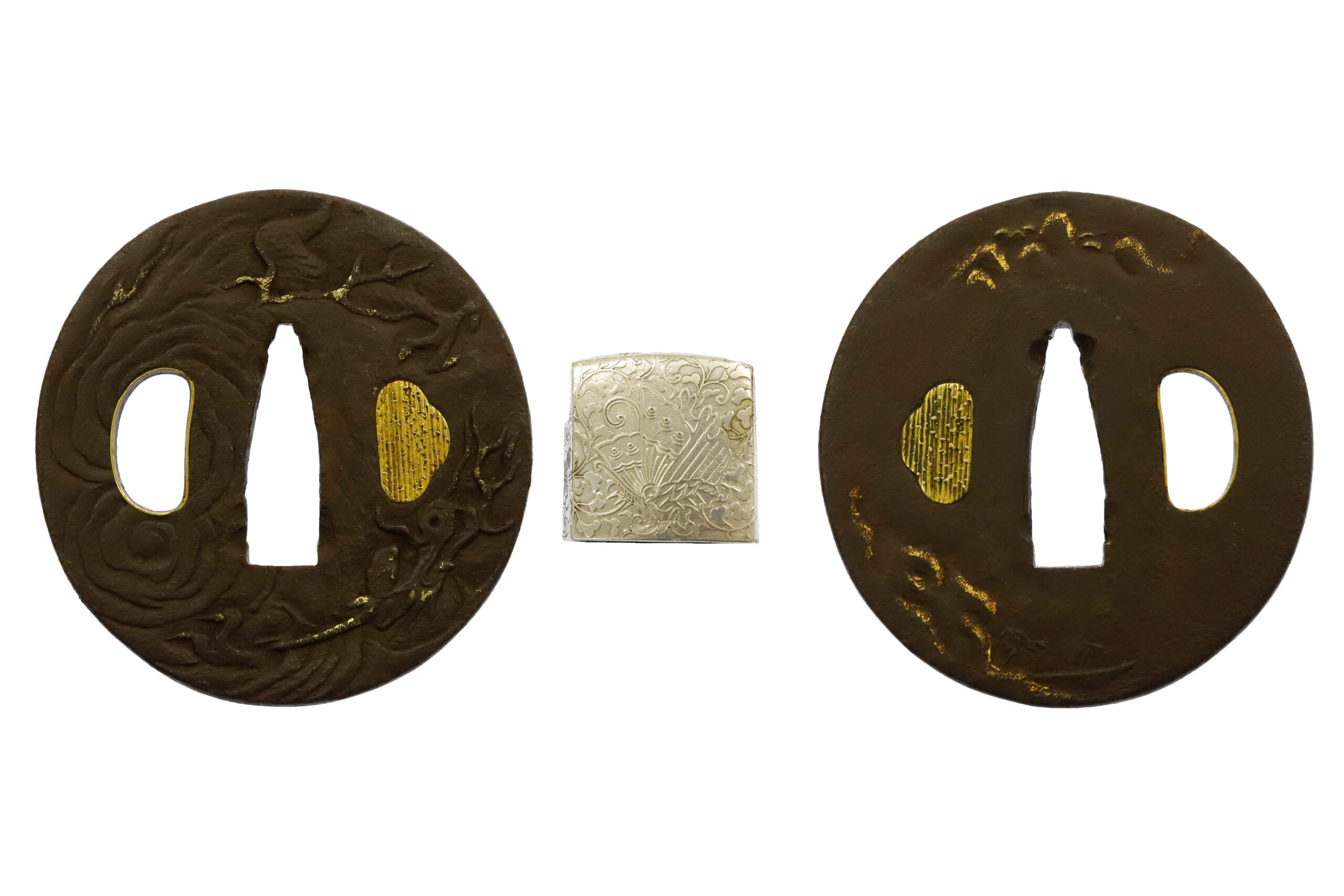
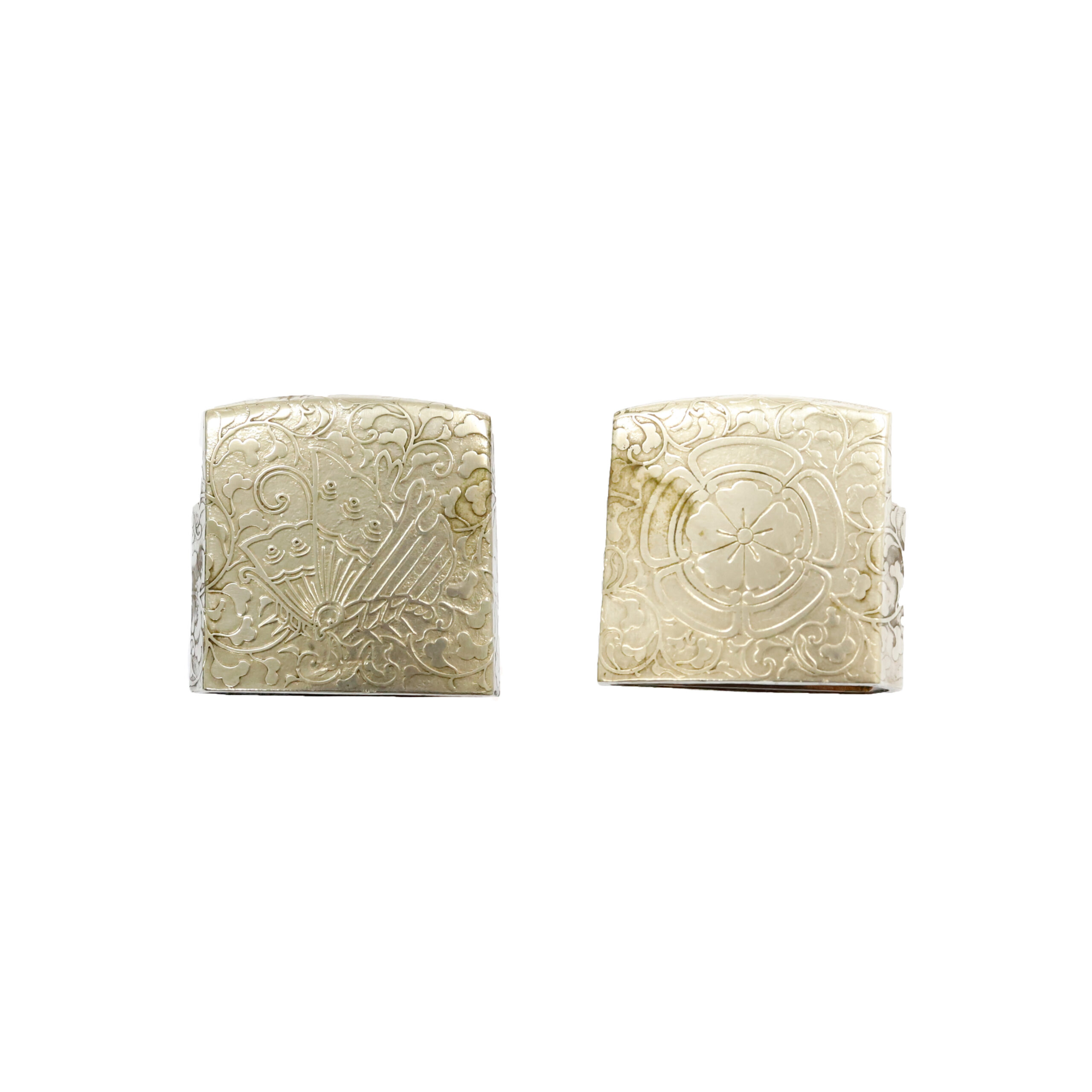
Kozuka:Kozuka is a small knife stored in Kozuka Hitsu(groove of the sheath of the Japanese sword).
A Kogatana (小刀, small knife) is stored in the Kozuka. A Hannya-no Men (般若の面) is designed. It is one of the masks that is used in Noh (能, a major form of classical Japanese dance-drama) parformances. The Hannya-no Men is a vengeful spirit mask that expresses a woman’s jealousy and resentment. The upper half of the face has a sad expression with furrowed eyebrows, while the lower half has a wide open mouth expressing anger. Anger and sadness, it is a structure that expresses the duality of two emotions. This Kozuka’s maker might have had a deep knowledge of traditional performing arts.
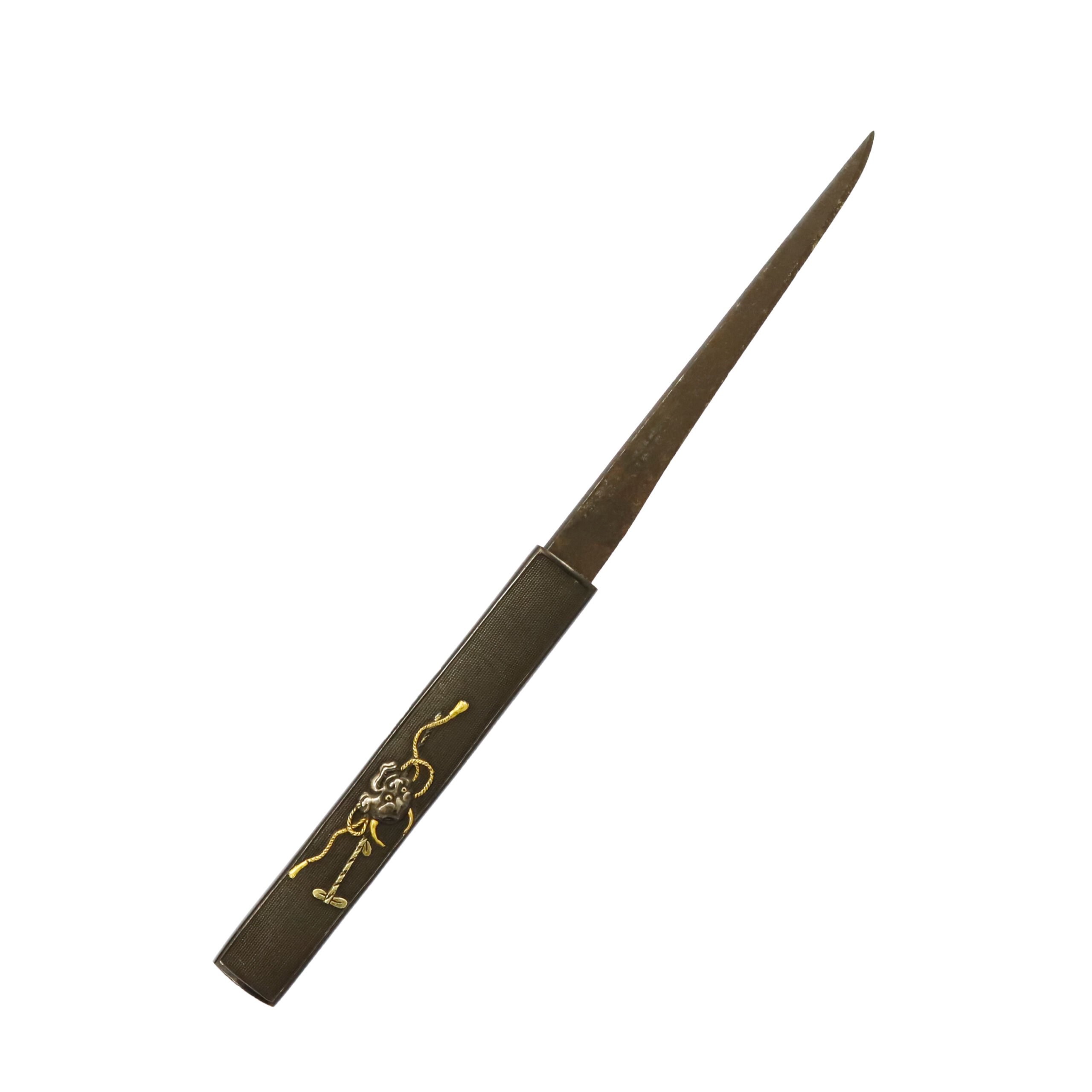
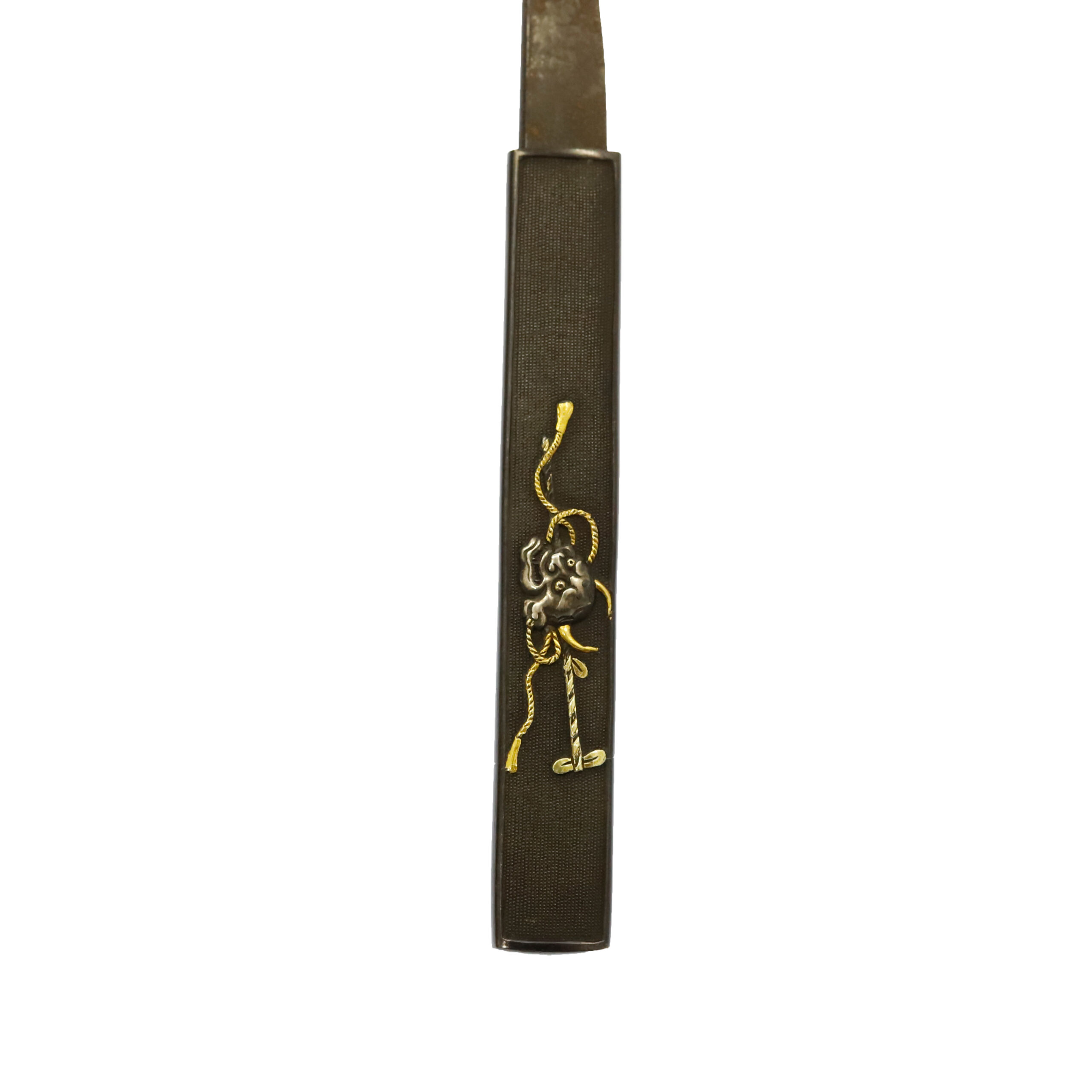
Saya: Saya is the scabbard for the Japanese sword.
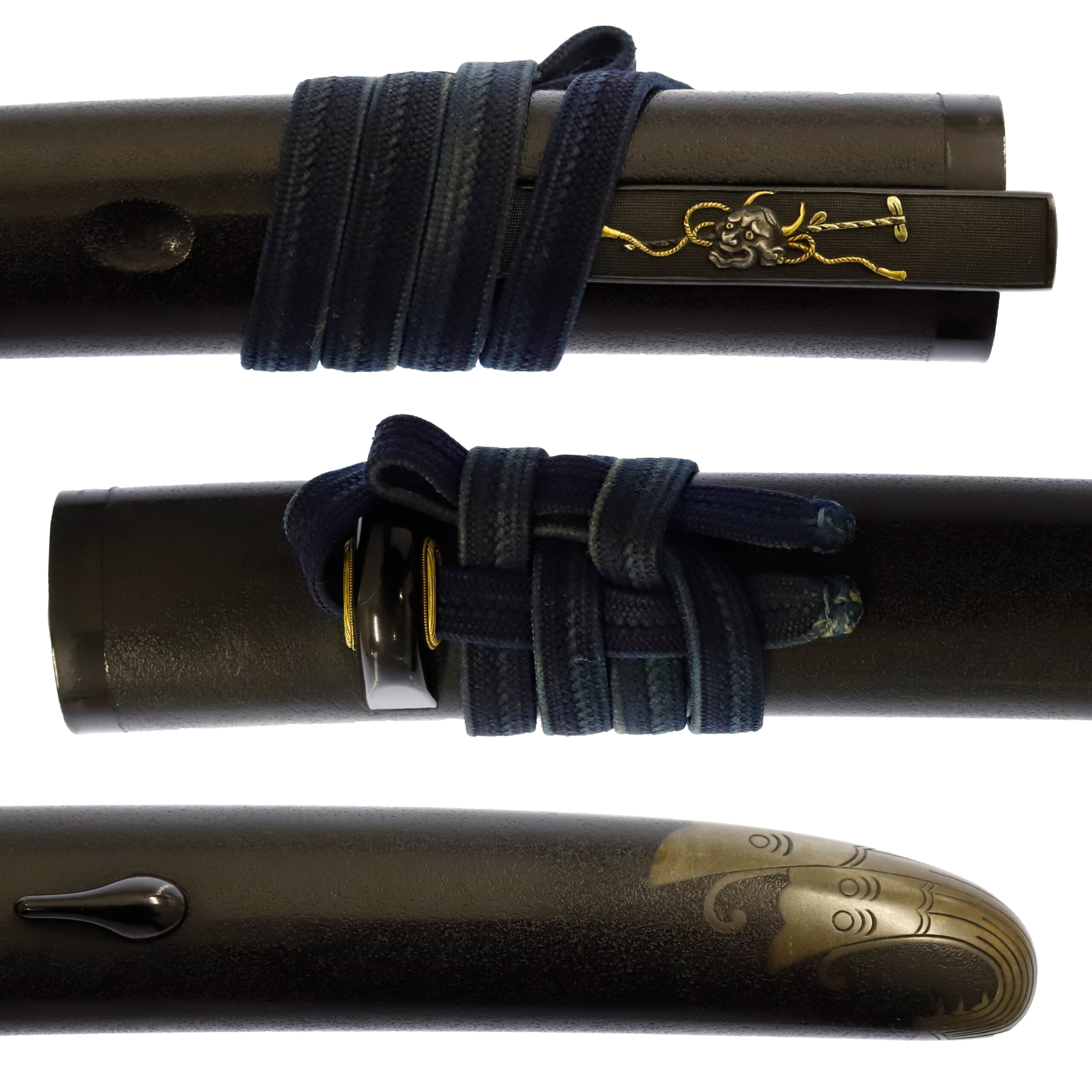
Authentication Paper:NBTHK Tokubetsu Hozon Certificate for the blade (No.1018202)
NBTHK, also known as Nihon Bijutsu Touken Hozon Kyokai (the Society for the Preservation of the Japan Art Sword), is one of the oldest Japanese sword appraising organizations in modern-day Japan. They authenticated the blade on June 3rd in the 4th year of Reiwa (2022). They appraised it as Tokubetsu Hozon Touken, the blade especially worth preserving for Japanese society. The purchaser will receive this original certificate as well. We can also translate what is written into English and make a PDF file for your record if you request.

Registration Number : Ishikawa 27127
The Board of Education in Ishikawa prefecture issued a registration paper for this sword. It is called Jyu Token Rui Torokusho(銃刀剣類登録証). Bunkacho(The Agency for Cultural Affairs) acknowledges a Japanese sword with this paper as a work of art.
The sword needs to be traditionally hand-forged and made of Tamahagane carbon steel to be registered in the system. With this paper, its owner in Japan can legally own an authentic Japanese sword. Based on this registration number, we will apply for its export permit.
This paper will need to be returned to the board of education when the sword is being shipped abroad, but you can receive a copy of it. An English translation of this registration paper is available on request.

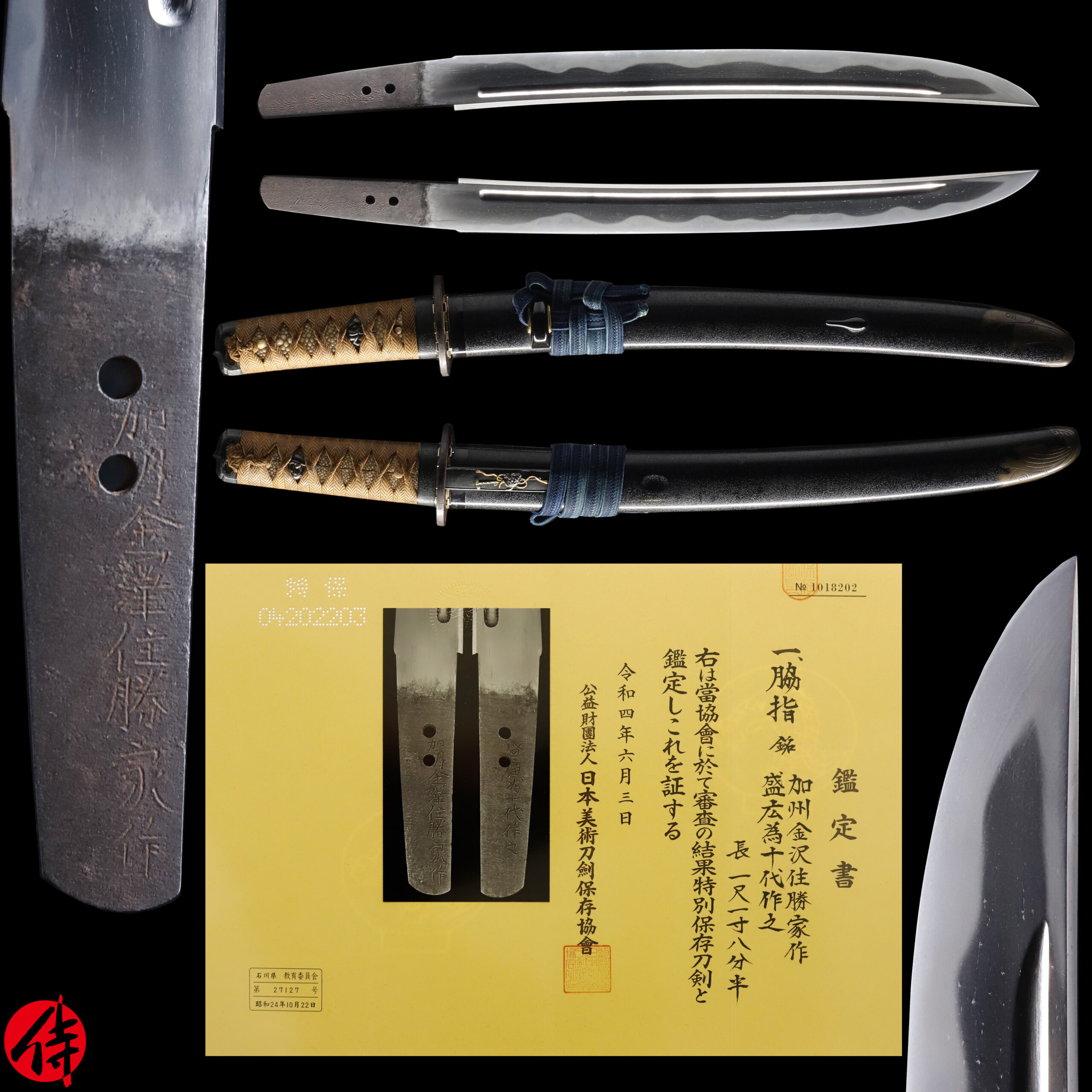
—————————————————————–
【About us】
Samurai Museum is located in Tokyo, Japan, exhibiting antique artifacts related to the Samurai history. Samurai Museum Shop is the place for those who are interested in Japanese culture and craftsmanship. We deal with antique Samurai swords/armor, traditional crafts made in Japan and so on.
【Japanese Sword& Export Process】
The Japanese swords we deal with are hand-forged edged swords made in Japan. It was made from the traditional carbon steel called TAMAHAGANE(玉鋼). Samurai Museum is familiar with the proper legal procedure for an antique/ authentic Japanese sword to be exported from Japan. We have sent more than 500 Japanese swords for the past three years (~2023) to amazing owners who appreciate its historical value.
Each Japanese sword is registered under the Agency for Cultural Affairs and the Board of Education in Japan. They issue a registration paper for each Japanese sword for its owner in Japan to legally possess it. The Japanese sword with its registration paper means it was traditionally hand-forged in Japan.
To legally export the sword from Japan to other countries, we will have to apply for its permit to the Agency for Cultural Affairs(Bunkacho) and return the original registration paper to the Board of Education. It normally takes around 2-4 weeks to receive this permit after submitting required documents. And we would like you to expect at least 1-1.5 months for your order to arrive at your given address after you ordered. For more detailed info, please click here.
It is allowed for residents in Japan to own authentic Japanese swords without a special license as long as they come with registration papers. Please feel free to contact us if you are a resident of Japan, whether temporarily or permanently. We will also assist you when you leave Japan and need to obtain the export permit.
【Payment Method】
We accept payment through Stripe (Credit card), PayPal, Apple Pay or ChromePay, all of which are secure payment methods. Also, you don’t need to make an account on Stripe for the checkout. If you prefer other payment method, please contact us. After confirming your payment, we will apply for an export permit. You may either pay in JPY, USD, AUD, CAD,EUR CHF or GBP. The price is set in Japanese Yen. Prices in other currencies are automatically calculated based on the latest exchange rate.

* If the amount is above 1 million JPY, Stripe or wire transfer will be the only options for payment.
【Shipping】
We have shipped authentic Japanese swords to the USA, UK, Canada, Mexico, Germany, Switzerland, France, Hong Kong and Australia. If you don’t live in these countries and like to order, please contact us first before making a purchase. We offer Free International Shipping as long as we can send antique Japanese swords by EMS.
We normally ship by EMS(Express Mail Service) provided by Japan Post. We will send you a tracking number for your order as soon as we hand it to the post office. We will put 100 % insurance on the shipping document without any extra charge. Based on the total amount, there might be a duty tax or other fee for you to pay, depending on the countries. We use package cushioning to protect the item and put it in a PVC pipe, which is one of the most secure packages because of its durability.
It will normally takes 5-14 days for the item to arrive at your given address after we dispatch it. Time of delivery is estimated as accurately as possible by the carrier but does not take into account any delays beyond our control such as by inclement weather, post office holiday seasons.
* If you live in Australia and like to purchase an authentic Japanese sword, please click here to know the detail.
*Please keep in mind that due to the spread of COVID-19, there might be delays in shipping. If you like to know the detail about shipping, please feel free to ask us.

【Review】
Here is one of the reviews we received from a customer who purchased an authentic Japanese sword from us. For more reviews, please click here.
“My experience overall with the whole process was wonderful. I had many questions about the history and process to purchase these treasures. All my questions were answered very timely and complete. The staff is very knowledgeable and very well versed if any questions do arise.”
【How to make sure the condition】
Please keep in mind that what you are going to purchase is an antique item. We uploaded high resolution photos for you to check its condition thoroughly. If you like to see more photos with different angles, please feel free to contact us. We will be happy to send them to you so that you can make informed decision. It is essential for us to know that you are happy with your choice of a sword. and we are prepared to use the best of our ability to serve you.
【How To Contact Us】
Please contact us through email, Facebook Messenger or Live Chat if you have any questions. You can find each icon on the right side of the website. Please click one of them to reach us. We will reply to you within 1-2 business days.
【The Art of Nihonto (Japanese Sword)】
Samurai’s history is a profound, eloquent legacy of ancient Japanese warriors in which millions of people worldwide are being fascinated. If you like to find out the art of Nihonto, please click here.
【A Guide to Japanese Sword Maintenance】
After acquiring an genuine Japanese sword, it is also important to know how to take good care of it. Here is the special video for you. Mr. Paul Martin, Japanese sword expert, shows you how to give proper maintenance to your sword. By mastering how to clean the Japanese sword, its aesthetic beauty will last forever.
When you purchase a Japanese sword from us, you can get a Free Japanese sword maintenance kit. It comes with four tools(Choji Oil, Uchiko Whetstone Powder, Peg remover, Oil Applicator). By watching the video instruction above , you can enjoy learning how to maintain your Japanese sword while appreciating it. If you have any difficulty assembling the sword or cleaning the blade, you can feel free to contact us.


MORE ANTIQUE JAPANESE SWORD FOR SALE
SWORDS WITHOUT CERTIFICATES FOR SALE
LEARN JAPANESE SWORD TERMINOLOGY
Thank you for reading all the information on the page. If you have any difficulty choosing the right Japanese sword for you, we will be more than happy to help you find the one that speaks to you the most. Please feel free to contact us.
